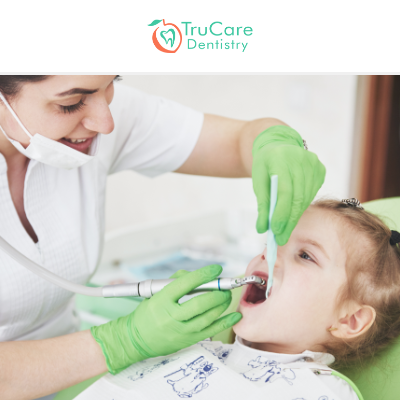
Teething turns out to be easier for most babies but more challenging for a few. Yet, it’s always a moment of joy for parents when their baby reaches the first tooth milestone.
Are you worried about the presence of strange bumps or bubbles on the baby’s gums? No worries, those might be generally harmless eruption cysts.
TruCare also offers dentistry for children. Each month, we help several parents worried about these strange bubbles on baby gums. Let’s take a look at all the crucial aspects of eruption cysts.
What triggers the formation of eruption cysts?
When the tooth is set to erupt through bone tissues and gums, fluids start accumulating around it. The liquid results in the formation of a bubble, and it rises out of the gums. Parents often see it just a few days before the baby starts teething. They appear on the gum tissue, precisely above the tooth about to erupt.
Bubbles form at least four days before the eruption of the emerging tooth crown. They may also develop within three days post the eruption of the new tooth.
The exact reasons behind the formation of eruption cysts are unknown. However, examining them can assist in understanding the possible triggers. An infection in gums, inflammation, or trauma can cause the same. Other possible reasons are overcrowding in gums, dental decay, or injury in the gums. Eruption cysts also arise due to genetics.
Your baby can end up with an injury in the gums while teething with a toy, and you won’t know a thing. Thus, let your dentist examine and ensure the condition is under control.
How do eruption cysts appear?
Eruption cysts are also referred to as eruption hematomas. The bump, bubble, or bruise might be dark reddish-brown or bluish-purple in most cases. It often seems like a pocket or sac of fluid mixed with blood.
Which are the most commonly reported symptoms associated with an eruption cyst?
- An infected eruption cyst results in a foul smell.
- The baby starts feeling uncomfortable due to the presence of unsightly bubbles on the gums.
- Tooth fails to erupt properly and starts causing pain.
- Gums bleed with unusual pain near the eruption cyst.
- You can easily compress typical cysts.
- In some cases, cysts can be asymptomatic.
What’s a dentigerous cyst?
There are certain cases where the tooth grows despite the presence of the cyst. The condition is known as a dentigerous cyst.
For such cases, the dentist might recommend the removal of the bubble as well as the associated tooth.
You might require to opt for a 3D CBCT scan and dental x-rays to determine the position of the cyst. Your dentist will examine all the reports and make the treatment decision.
When’s the time to ring the alarm bells?
It’s advisable not to ignore eruption cysts for more than two weeks. It will help if you immediately approach your pediatric dentist in case of swelling. Besides making the toddler uncomfortable, it also causes feeding problems.
Babies need a dental check once every six months like adults. Ensure you take your baby to a dental clinic at least once before the first birthday.
Are eruption cysts common in babies? What about adults?
Eruption cysts formation is rare. As mentioned earlier, medical intervention might not be necessary in most cases. But it’s always better to remain alert. Don’t hesitate to visit your dental clinic if the area around the bubble starts swelling.
Eruption cysts also occur when permanent teeth are about to erupt. Children in the six to thirteen age group are more prone to this condition compared to babies.
In adults, cysts are formed in gums, around infected teeth roots, and within the jawbone.
Treatment options for eruption cysts cases
In most cases, eruption cysts do not need any intervention. They burst on their own within a few days.
Surgical intervention becomes necessary if these bumps start causing pain. Infected bubbles might start bleeding, and such patients need immediate attention.
Depending on the condition of the bubble, your pediatric dentist might remove the top layer of the cyst and drain out the fluid. The procedure can help in tooth eruption by making way for the tooth’s crown.
Dentists choose between laser cutting or traditional surgery depending on the size of the cyst. The aim is to complete the process with minimum bleeding.
Specialists administer local anesthesia to ensure the child does not experience discomfort. Yes, it’s a pain-free procedure. In case of any infection, your dentist will prescribe antibiotics for quick healing.
The endnote:
Maintaining proper oral hygiene can help ensure cysts heal on their own. Parents might experience a wave of anxiety even due to a slight issue with the baby’s oral health. If you are in Roswell (GA), feel free to fix an appointment and visit our clinic with your baby.
